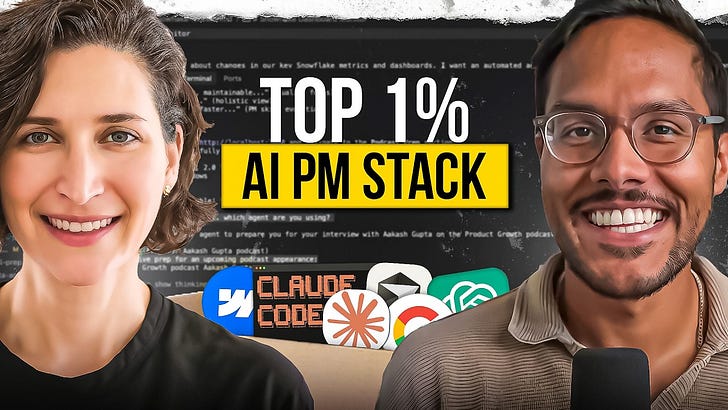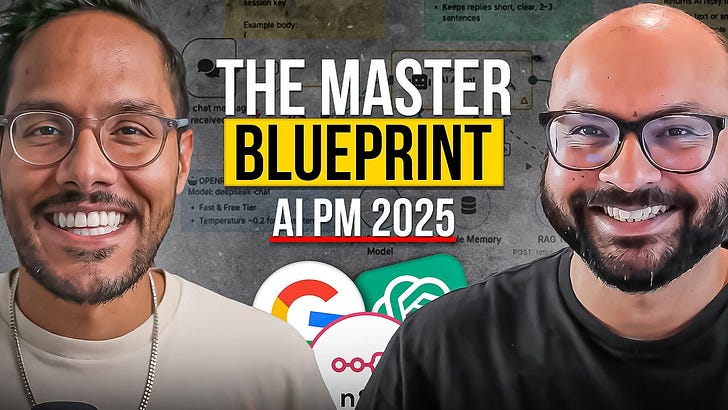Listen now on Apple, Spotify, or YouTube.
And check out our sponsors:
Maven: Get $100 off their courses with code AAKASHxMAVEN
GibsonAI: The awesome new AI Database Engineer startup for you
Amplitude: Try their 2-minute assessment of your company’s digital maturity
Today’s Episode
In my recent “Mastering AI” episodes, we’ve seen what’s truly possible for product managers:
Colin walked through building 5 real features using 5 different AI tools (yes, Bolt was one of them).
Tal showed how AI can streamline the 10 most common PM workflows.
Today, we’re back with Eric Simons, Co-founder and CEO Bolt, and we live-build a remote job board, a full-stack clone of Remote OK using Bolt’s AI-native development environment.
No vague instructions. No “talking about it.” Just building, right there with you.
If you’ve been sitting on a side project or dreaming of launching something like Claire’s, this episode will show you how do it right!
We cover:
Building Remote Job Board in Bolt – 00:00:17
Writing PRDs in Bolt – 00:10:26
Debugging Errors – 00:21:36
Uploading the Code to GitHub – 00:43:00
Launching Mobile Apps – 00:52:09
Here’s a quick summary of our conversation.
10-Step Guide to Building a Remote Job Board with Bolt
Eric live-built a full-stack remote job board — complete with login, real job listings, and SEO-ready pages — using Bolt and an AI agent.
No local setup. No dev team. No nonsense.
Just prompts, product thinking, and rapid iteration.
This is the new playbook for PMs who want to go from idea → working product fast.
Let’s walk through exactly how he did it.
Step 1: Start with a clear reference, not a blank canvas
Before writing a single prompt, define what you’re building.
Choose a proven product to clone or reimagine — like Remote OK or We Work Remotely. Break down what makes it successful:
SEO-first structure
Clean UI for browsing jobs
Monetization via promoted listings
You’re not inventing a category. You’re competing on execution.
Step 2: Open Bolt and create your app with a simple prompt
Bolt is a browser-based AI IDE that responds to natural language.
Prompt example:
“Create a remote job board with job search, posting, and user login.”
The AI agent will scaffold the frontend and backend instantly. No setup needed.
This is your foundation.
Step 3: Connect a Supabase backend in minutes
Use Bolt’s integration to spin up a Supabase instance.
This gives you:
User authentication (sign-up, login)
A real database for job listings
Secure backend infrastructure
Everything connects in the background. No devops required.
Step 4: Add a job posting form
Prompt the AI to add fields like:
Job title
Remote or in-office
Salary range
Company name and logo
Application link or email
The AI will create the form, wire it to Supabase, and handle the data flow.
This makes the app interactive.
Step 5: Enable authentication before submissions
When users try to post a job, they need to be logged in.
Prompt example:
“Add user registration and login using Supabase.”
The AI will wire up the auth flow, including session management and error handling.
Now you’ve got a gated experience ready to monetize.
Step 6: Pull in external job listings via API
To make the board feel real from day one, fetch live job data.
→ Use the Findwork.dev API to populate listings.
Prompt example:
“Connect the Findwork API and display the job listings on the homepage.”
This seeds your site with relevant, real-time content — no manual input needed.
Step 7: Bypass API integration issues like CORS
You may hit cross-origin errors when calling external APIs. Eric did in our demo.
Instead of searching forums, use prompt like:
“Use a local proxy server to route API requests.”
The AI will spin up a Node.js proxy inside the browser, solving the issue on the spot.
Modern debugging is now collaborative, not technical.
Step 8: Cache API data into your own database for SEO
Live API content isn’t SEO-friendly — it’s not indexed, and it disappears.
Prompt example:
“Store fetched job data into Supabase as cached jobs.”
Now you can create individual, static job pages that:
Load instantly
Are Google-indexable
Stay available even if the API fails
This unlocks long-tail search growth.
Step 9: Clean up the frontend to only show cached listings
Once jobs are stored in your database, tell the AI to:
“Only display jobs that are saved in Supabase.”
This ensures every listing has a working detail page and removes reliance on external services for UI integrity.
Your site now behaves like a real product.
Step 10: Refresh, refine, and go live
If something breaks or gets stuck, hit refresh.
Bolt resets everything instantly — it runs entirely in the browser.
No broken environments. No dependency issues.
Your remote job board is now fully functional:
Frontend built
Backend integrated
Auth flow working
Real jobs displayed
SEO-ready content
No engineers involved
2 Insights You Shouldn’t Miss
This episode genuinely blew my mind.
The possibilities of what you can build today (without knowing how to code) are borderline unreal.
Here are the two insights I seriously don’t want you to miss:
1. Why “Vibe Coding” Fails Without a PRD
There has been a trend of “vibe coding” but more of it is just coding for the sake of it.
Yes, some people are extremely successful at this but they’re just the outliers.
If you seriously want to build something valuable without knowing coding, you need the PRD and proper roadmap.
The app broke when they kept changing direction. Why?
Because AI can’t read your mind if you keep rewriting it mid-flight.
Start with a PRD. Not a Figma. Not a feeling. A real spec.
Vibe coding works for UI tweaks; not when you're switching the backend model halfway.
If you don’t set the right scope up front, AI gets lost. Just like a junior dev would.
If you’re a PM using AI, remember: it’s not magic. It's pattern matching.
Garbage in = garbage out.
2. Full-Stack App in a Browser? It’s Already Here
Eric built a freaking working job board — with Supabase backend, login, API integration — all in the browser.
No VS Code. No deployment pipeline. Just Bolt.
Here’s what changed:
Supabase gets spun up in minutes. Auth flows are one-click.
Backend integration is no longer a PM blocker, it’s part of your playground.
Want to scale? You don’t even need to leave the browser.
If you’re still waiting for eng bandwidth to prototype ideas, you're already behind.
Now It’s On You!
You’re not waiting for bandwidth anymore.
AI lets product thinkers become product builders.
And when you can ship MVPs without blocking on engineering, you move faster, test faster, and learn faster.
The only thing between you and a working product is a great prompt.
Make it count.
That was just a summary. Watch the full episode for more!
Where to Find Eric
If you prefer to only get newsletter emails, unsubscribe from podcast emails here.
If you want to advertise in the podcast, email productgrowthppp at gmail.
Up Next
I hope you enjoyed the last episode with Tal Raviv (where we built an AI PM in only 58 minutes). Up next, we have episodes with:
Lewis Lin - Author, Decode and Conquer
Bryan Helmig - CTO and Founder of Zapier
Kate Syuma - Ex. Head of Growth Design at Miro
Finally, check out my latest deep dive if you haven’t yet: OpenAI Deep Dive: How to Break Into the World's Hottest Company
Cheers,
Aakash











